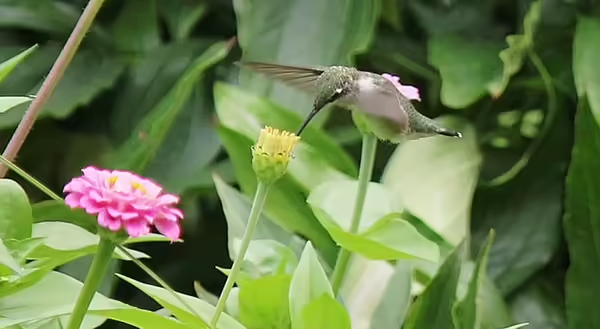
By Jeff and Nancy Staecker, Extension Master Naturalists serving Fulton, Mason, Peoria and Tazewell counties
Over the last 20 years we’ve lost billions of birds – birds that are both beautiful and play critical roles in the environment… such as eating pests. We do not know all the complex drivers leading to the population decline of birds, but habitat loss is certainly part of the story. We know habitat loss decreases the availability of food for birds such as pollen, seeds, and insects. Birds need a variety of food sources – did you know that baby birds, even hummingbirds, depend on insects as a food source?
Lawns to Blooms to Birds project
The driving force for “Lawn to Blooms to Birds” is to encourage people to replace a portion of their lawn with flowers that both enrich the beauty of a yard and provide food sources for birds. We love the look of a green lawn but recognize that grass mowed weekly is a poor habitat for birds nor does it produce the flowers, seeds, and insects that birds need to live and thrive. "Lawn to Blooms to Birds" is intended to appeal to flower and bird lovers as well as conservationist with an appeal suitable for small yards in urban areas.
When replacing lawns with the goal of encouraging birds, it is best practice to:
- plant native perennials that are adapted to our weather and soils
- minimize pesticide use
- keep previous year's growth long enough to allow insect eggs to hatch
Start small with new flower garden plans
Planning a new flower garden is exciting, it can also be challenging for some. The details can lead to procrastination and the choices numerous as one plans where to put the garden, how big to make it, how to edge it, what type of soil, how to improve the soil, and how much light and water the garden receives. It’s also important to avoid buried utilities and consider drainage when preparing to put in a garden. It’s after this preparation that it’s time for choosing plants! This is when we encourage you to slow down, start small, and enjoy the flowers and bees and birds.
A small garden patch with colorful annuals and perennials is a perfect beginning. Watch your flowers grow all season long and look at the bees and butterflies that visit and the birds that feed their young. And realize that you have made a difference in your world, here and now. And that successful start can lead to a few more plants in the garden, more perennials including native plants that are adapted to our weather and soils. And these native plants are the best food sources for bees and butterflies and up the food chain to birds.
Ideas to expand the garden
Then you can expand your garden to include other types of plants such as grasses and sedges, bulbs and vines. With larger gardens one can include different types of bushes that have flowers and colorful leaves for seasonal interest and berries for food. Even a tree can be chosen to help wildlife, a nut or fruit tree or evergreen can provide food as well as nesting places.
And the success of a few flowers grows. And one garden becomes a neighborhood, and that becomes our world.
Additional Resources
Native plant education aids natural habitat preservation
Lawns to Blooms to Birds flyer
ABOUT THE AUTHORS
Jeff and Nancy Staecker, Extension Master Naturalists serving Fulton, Mason, Peoria, and Tazewell counties
Nancy and Jeff are “native” to the great state of Illinois and obtained their Bachelor of Biology degrees from Illinois State University. Jeff carried on to his PhD from UW- Madison, as Nancy completed her certification in Medical Technology. They made moves around the Midwest and Northeast as careers developed while enjoying flower gardens combining perennials and annuals. Now back in Illinois and semi-retired, they can enjoy again gardening with annuals and perennials with special attention to native plants that support insects and birds.
ABOUT THE BLOG
ILRiverHort is a blog that helps people connect to nature and grow.